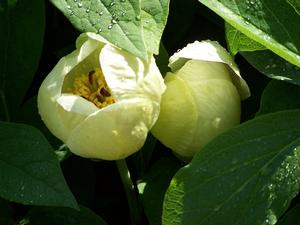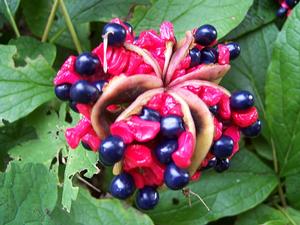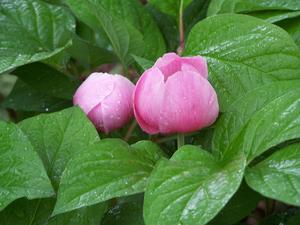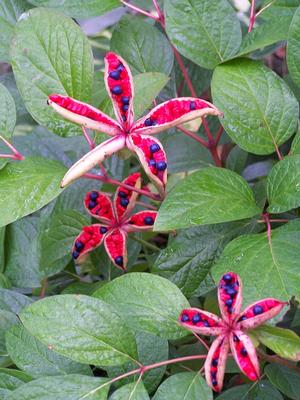
Paeonia japonica just opening in early May

Paeonia japonica be-jeweled seed head on 8.23.2014

Paeonia obovata beginning to flower

Paeonia obovata seed pods are like spectacular tropical starfish
Two Woodland Peonies
When we think of peonies most of us picture the wonderful old-fashioned P. lactiflora hybrids that live on in the memories of our grandmothers' gardens. Exceptionally long-lived, around a century or longer, they are sun-loving and quintessential June bloomers. There are a number of other herbaceous Eurasian and Balkan peonies plus one that is barely known from western North America, Paeonia brownii.
A different group of peonies are the so-called tree peonies which prefer part shade. P. suffruticosa blooms on old wood, from last year's woody stems which will have survived the vagaries of winter. These should never be chopped down at the end of the season when one performs the task of garden clean-up. If you do you will destroy the germinal flowers sleeping in those stems and it may take years for the shrub to recover its former glory. There is an extraordinary new set of hybrids between P. lactiflora and P. suffruticosa have recently been introduced. These are commonly called the Itoh Peonies. These demonstrate qualities of both species, relish basking in the sun and display a broadened color range in the extra-large flowers very reminiscent of P. suffruticosa parentage. They are dashing and exceptional.
Too often ignored in the amazing world of peonies are the charming woodland peonies from Asia. Closely related to the lactifloras they succumb to the tuber when temperatures grow cold. Unlike the lactifloras, they prefer the protection of shade to dappled light but will tolerate morning sun if not too hot. Strong-stemmed they do not require staking and their gem-like seed pods add unusual beauty and texture at the end of the growing season. Flowers are simple and lovely. I would like to illustrate two of my favorites, both having beautiful single, elegant flowers with the added bonus of striking late season fruiting displays. Paeonia japonica hales from Japan and with broader reach is P. obovata whose nativity extends from Japan into China.
PAEONIA JAPONICA
Paeonia japonica is very early flowering in northeastern Connecticut, late April when milder to early May if the winter is long. Rounded, bowl-shaped singular flowers are satiny white to cream-ivory. Buds typically occur at the terminal tops of stem which stand 16 to 20 inches tall, the entire plant growing 24 to 30 inches wide. Foliage remains clean and green all through the growing season.
Hardy from USDA zones 5 to 8 this lovely peony demonstrates surprising frost tolerance. The flower's delicate charm belies its apparent toughness having survived multiple frosts during this tricky time of the season through the years without damage. There will be some browning of petal edges if the temperature plummets to unusual cold and remains very low for some time but even then unopened buds remain unscathed. After having grown this species for years I am still surprised by its early arrival and delighted at its simple beauty.
Following the flowering event comes the seed. These stubby, truncated "bean pods" radiate outward where they meet the stem juncture. Usually in pairs or threes as many as five rolled fingers may occur ending in a point. They remain tightly closed throughout the summer. But finally these split open, downturn and unroll from the top center and whole new world of late season beauty arrives. They reveal fluorescent red flesh, a brilliant hue. Embedded in and rising above this flesh are fat, round and dark blue semi-glossy berries. These dark berries hold viable, pollinated seed. The blue on red is amazing on an fascinatingly-shaped seeding structure like a gem-studded broach adding eye-popping interest in the late season woodland garden.
PAEONIA OBOVATA
Paeonia obovata flowers in early summer with showy, single pink flowers many weeks later than P. japonica. The welcome flowers set atop stems which can grow to 20 inches tall but may stretch 30 inches. Dark green foliage is handsome all through the growing season. Sometimes when temperatures cool in late season the leaves pick of gold to reddish overtones just in time for autumn. Paeonia obovata is even more cold hardy than its close cousin, through USDA climate zone 4 and extends its range to zone 8.
Seed pods develop and hold through the summer. They are even larger and more dramatic than those of P. japonica. When occurring in sets of three they are delightfully reminiscent of medieval jesters’ hats. When five-pointed they remind one of beautiful green starfish. We have seen as many as seven-pointed seed pods like spokes of a wheel. In autumn they metamorphose into exotic, bejeweled starfish when they split open to reveal a brilliant crimson, fleshy backdrop, foil to the studded dark blueberry-like fruits which are vessels holding pollinated seed. Upon close inspection there is a rich red-violet hue exhibited on the inner skin of the pods augmenting the richness of the event which extends for many weeks. Part of the autumn processional it is almost like a second flowering making for striking interest.
Both these species will slowly self-sow if seed is not harvested in garden areas - doubtful this could, would or should ever be considered a technical "invasive". Culture for both these species is not difficult. They relish a moisture retaining and draining organic woodland soil. As with the lactifloras do not plant the dark red eyes near or at the tops of tubers more than 2 inches below the soil surface. Deep planting will scuttle flowering. Autumn planting is fine. Spring planting is possible with potted stock. A light organic mulch will retain soil moisture and encourage cooler soil temperatures. A third benefit is that as the mulch breaks down it feeds the soil in a natural cycle; feed the soil and the soil will feed the plants.
We would not be without these beautiful, easy-natured members of royalty in our woodland realm. They enrich the palette and augment depth and beauty both in spring and autumn. Any herbaceous perennial that exhibits multiple seasons of interest should be given priority in today's smaller gardens. We need to capitalize and extract as much beauty for as long as possible from every plant we grow. Both Paeonia japonica and P. obovata fulfill this requirement. Dig in. Have fun.
Penned by Wayne Paquette, 2015